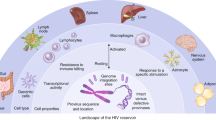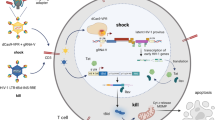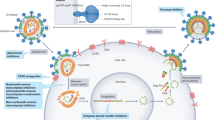Abstract
Acquired immunodeficiency syndrome (AIDS), caused by human immunodeficiency virus (HIV), kills millions worldwide every year. Vaccines against HIV still seem a distant promise. Pharmaceutical treatments exist, but these are not always effective, and there is increasing prevalence of viral strains with multidrug resistance. Highly active antiretroviral therapy (HAART) consists of inhibitors of viral enzymes (reverse transcriptase (RT) and protease). Gene therapy, first introduced as intracellular immunization, may offer hopes for new treatments to be used alone, or in conjunction with, conventional small molecule drugs. Gene therapy approaches against HIV-1, including suicide genes, RNA-based technology, dominant negative viral proteins, intracellular antibodies, intrakines, and peptides, are the subject of this review.
This is a preview of subscription content, access via your institution
Access options
Subscribe to this journal
Receive 12 print issues and online access
$259.00 per year
only $21.58 per issue
Buy this article
- Purchase on Springer Link
- Instant access to full article PDF
Prices may be subject to local taxes which are calculated during checkout

Similar content being viewed by others
References
Blesch A . Lentiviral and MLV based retroviral vectors for ex vivo and in vivo gene transfer. Methods 2004; 33: 164–172.
Muhlebach MD et al. Transduction efficiency of MLV but not of HIV-1 vectors is pseudotype dependent on human primary T lymphocytes. J Mol Med 2003; 81: 801–810.
An DS et al. Efficient lentiviral vectors for short hairpin RNA delivery into human cells. Hum Gene Ther 2003; 14: 1207–1212.
Mautino MR, Morgan RA . Gene therapy of HIV-1 infection using lentiviral vectors expressing anti-HIV-1 genes. AIDS Patient Care STDS 2002; 16: 11–26.
Trono D . Lentiviral vectors: turning a deadly foe into a therapeutic agent. Gene Therapy 2000; 7: 20–23.
Connolly JB . Lentiviruses in gene therapy clinical research. Gene Therapy 2002; 9: 1730–1734.
Duprâe L et al. Lentiviral vector-mediated gene transfer in T cells from Wiskott–Aldrich syndrome patients leads to functional correction. Mol Ther: J Am Soci Gene Therapy 2004; 10: 903–915.
Kurre P et al. Efficient marking of murine long-term repopulating stem cells targeting unseparated marrow cells at low lentiviral vector particle concentration. Mol Ther: J Am Soci Gene Therapy 2004; 9: 914–922.
Miyoshi H . Subteam for Manipulation of Cell Fate, Gene delivery to hematopoietic stem cells using lentiviral vectors. Meth Mol Biol (Clifton, N.J.) 2004; 246: 429–438.
Stitz J et al. A novel lentivirus vector derived from apathogenic simian immunodeficiency virus. Virology 2001; 291: 191–197.
Curran MA et al. Efficient transduction of pancreatic islets by feline immunodeficiency virus vectors1. Transplantation 2002; 74: 299–306.
Poeschla EM . Non-primate lentiviral vectors. Curr Opin Mol Ther 2003; 5: 529–540.
Saenz DT, Poeschla EM . FIV: from lentivirus to lentivector. J Gene Med 2004; 6 (Suppl 1): S95–S104.
Luis Abad J et al. Novel interfering bifunctional molecules against the CCR5 coreceptor are efficient inhibitors of HIV-1 infection. Mol Ther 2003; 8: 475–484.
Venkatesan S et al. Reduced cell surface expression of CCR5 in CCR5Delta 32 heterozygotes is mediated by gene dosage, rather than by receptor sequestration. J Biol Chem 2002; 277: 2287–2301.
Yang S, Sun Y, Zhang H . The multimerization of human immunodeficiency virus type I Vif protein: a requirement for Vif function in the viral life cycle. J Biol Chem 2001; 276: 4889–4893.
Yang B et al. Potent suppression of viral infectivity by the peptides that inhibit multimerization of human immunodeficiency virus type 1 (HIV-1) Vif proteins. J Biol Chem 2003; 278: 6596–6602.
Hrimech M et al. Human immunodeficiency virus type 1 Vpr-mediated G(2) cell cycle arrest: Vpr interferes with cell cycle signaling cascades by interacting with the B subunit of serine/threonine protein phosphatase 2A. EMBO J 2002; 21: 3918.
Elder RT et al. HIV-1 VPR modulates cell cycle G2/M transition through an alternative cellular mechanism other than the classic mitotic checkpoints. Front Biosci: J Virtual Library 2002; 7: d349–d357.
Sawaya BE et al. Transdominant activity of human immunodeficiency virus type 1 Vpr with a mutation at residue R73. J Virol 2000; 74: 4877–4881.
Yung E et al. Inhibition of HIV-1 virion production by a transdominant mutant of integrase interactor 1. Nat Med 2001; 7: 920–926.
Cordelier P, Zern MA, Strayer DS . HIV-1 proprotein processing as a target for gene therapy. Gene Therapy 2003; 10: 467–477.
Cordelier P et al. Inhibiting AIDS in the central nervous system: gene delivery to protect neurons from HIV. Molecular Ther: J Am Soci Gene Therapy 2003; 7: 801–810.
Goncalves J et al. Functional neutralization of HIV-1 Vif protein by intracellular immunization inhibits reverse transcription and viral replication. J Biol Chem 2002; 277: 32036–32045.
Tewari D, Notkins AL, Zhou P . Inhibition of HIV-1 replication in primary human T cells transduced with an intracellular anti-HIV-1 p17 antibody gene. J Gene Med 2003; 5: 182–189.
Herschhorn A, Admon A, Hizi A . Recombinant human antibodies against the reverse transcriptase of human immunodeficiency virus type-1. Biochim Biophys Acta 2003; 1648: 154–163.
BouHamdan M et al. Inhibition of HIV-1 infection by down-regulation of the CXCR4 co-receptor using an intracellular single chain variable fragment against CXCR4. Gene Therapy 2001; 8: 408–418.
Bai J et al. Inhibition of Tat-mediated transactivation and HIV-1 replication by human anti-hCyclinT1 intrabodies. J Biol Chem 2003; 278: 1433–1442.
Reynolds L et al. Repression of the HIV-1 5′ LTR promoter and inhibition of HIV-1 replication by using engineered zinc-finger transcription factors. Proc Natl Acad Sci USA 2003; 100: 1615–1620.
Segal DJ et al. Attenuation of HIV-1 replication in primary human cells with a designed zinc finger transcription factor. J Biol Chem 2004; 279: 14509–14519.
Takada N et al. RelA-associated inhibitor blocks transcription of human immunodeficiency virus type 1 by inhibiting NF-kappaB and Sp1 actions. J Virol 2002; 76: 8019–8030.
Michienzi A et al. RNA-mediated inhibition of HIV in a gene therapy setting. Ann NY Acad Sci 2003; 1002: 63–71.
Puerta-Fernandez E, Barroso-DelJesus A, Berzal-Herranz A . Anchoring hairpin ribozymes to long target RNAs by loop-loop RNA interactions. Antisense Nucleic Acid Drug Dev 2002; 12: 1–9.
Puerta-Fernandez E et al. HIV-1 TAR as anchoring site for optimized catalytic RNAs. Biol Chem 2003; 384: 343–350.
Ramezani A et al. Development and testing of retroviral vectors expressing multimeric hammerhead ribozymes targeted against all major clades of HIV-1. Front Biosci 2002; 7: a29–a36.
Jacque JM, Triques K, Stevenson M . Modulation of HIV-1 replication by RNA interference. Nature 2002; 418: 435–438.
Paul CP et al. Localized expression of small RNA inhibitors in human cells. Mol Ther: J Am Soci Gene Therapy 2003; 7: 237–247.
Lee NS et al. Expression of small interfering RNAs targeted against HIV-1 rev transcripts in human cells. Nat Biotechnol 2002; 20: 500–505.
Coburn GA, Cullen BR . Potent and specific inhibition of human immunodeficiency virus type 1 replication by RNA interference. J Virol 2002; 76: 9225–9231.
Boden D et al. Human immunodeficiency virus type 1 escape from RNA interference. J Virol 2003; 77: 11531–11535.
Das AT et al. Human immunodeficiency virus type 1 escapes from RNA interference-mediated inhibition. J Virol 2004; 78: 2601–2605.
Chiu YL et al. Inhibition of human immunodeficiency virus type 1 replication by RNA interference directed against human transcription elongation factor P-TEFb (CDK9/CyclinT1). J Virol 2004; 78: 2517–2529.
Cen S et al. Incorporation of lysyl-tRNA synthetase into human immunodeficiency virus type 1. J Virol 2001; 75: 5043–5048.
Guo F et al. Specific inhibition of the synthesis of human lysyl-tRNA synthetase results in decreases in tRNA(Lys) incorporation, tRNA(3)(Lys) annealing to viral RNA, and viral infectivity in human immunodeficiency virus type 1. J Virol 2003; 77: 9817–9822.
Anderson J et al. Potent suppression of HIV type 1 infection by a short hairpin anti-CXCR4 siRNA. AIDS Res Hum Retroviruses 2003; 19: 699–706.
Park WS et al. Specific HIV-1 env gene silencing by small interfering RNAs in human peripheral blood mononuclear cells. Gene Therapy 2003; 10: 2046–2050.
Lee MT et al. Inhibition of human immunodeficiency virus type 1 replication in primary macrophages by using Tat- or CCR5-specific small interfering RNAs expressed from a lentivirus vector. J Virol 2003; 77: 11964–11972.
Li MJ et al. Inhibition of HIV-1 infection by lentiviral vectors expressing Pol III-promoted anti-HIV RNAs. Mol Ther: J Am Soci Gene Therapy 2003; 8: 196–206.
Akkina R et al. siRNAs, ribozymes and RNA decoys in modeling stem cell-based gene therapy for HIV/AIDS. Anticancer Res 2003; 23: 1997–2005.
Eckert DM, Kim PS . Mechanisms of viral membrane fusion and its inhibition. Annu Rev Biochem 2001; 70: 777–810.
Carr A . Toxicity of antiretroviral therapy and implications for drug development. Nature reviews. Drug Discov 2003; 2: 624–634.
Baldwin CE, Sanders RW, Berkhout B . Inhibiting HIV-1 entry with fusion inhibitors. Curr Med Chem 2003; 10: 1633–1642.
Hildinger M et al. Membrane-anchored peptide inhibits human immunodeficiency virus entry. J Virol 2001; 75: 3038–3042.
Egelhofer M et al. Inhibition of human immunodeficiency virus type 1 entry in cells expressing gp41-derived peptides. J Virol 2004; 78: 568–575.
Baldwin CE et al. Emergence of a drug-dependent human immunodeficiency virus type 1 variant during therapy with the T20 fusion inhibitor. J Virol 2004; 78: 12428–12437.
Mergia A et al. The efficiency of simian foamy virus vector type-1 (SFV-1) in nondividing cells and in human PBLs. Virology 2001; 280: 243–252.
Garrus JE et al. Tsg101 and the vacuolar protein sorting pathway are essential for HIV-1 budding. Cell 2001; 107: 55–65.
Perez OD, Nolan GP . Resistance is futile: assimilation of cellular machinery by HIV-1. Immunity 2001; 15: 687–690.
Demirov DG et al. Overexpression of the N-terminal domain of TSG101 inhibits HIV-1 budding by blocking late domain function. Proc Natl Acad Sci USA 2002; 99: 955–960.
Martin-Serrano J, Zang T, Bieniasz PD . Role of ESCRT-I in retroviral budding. J Virol 2003; 77: 4794–4804.
von Schwedler UK et al. The protein network of HIV budding. Cell 2003; 114: 701–713.
Strack B et al. AIP1/ALIX is a binding partner for HIV-1 p6 and EIAV p9 functioning in virus budding. Cell 2003; 114: 689–699.
Ono A, Freed EO . Cell-type-dependent targeting of human immunodeficiency virus type 1 assembly to the plasma membrane and the multivesicular body. J Virol 2004; 78: 1552–1563.
Chakraborti S, Banerjea AC . Inhibition of HIV-1 gene expression by novel DNA enzymes targeted to cleave HIV-1 TAR RNA: potential effectiveness against all HIV-1 isolates. Mol Ther 2003; 7: 817–826.
Joshi PJ, Fisher TS, Prasad VR . Anti-HIV inhibitors based on nucleic acids: emergence of aptamers as potent antivirals. Curr Drug Targets Infect Disord 2003; 3: 383–400.
Xu X et al. Dominant effector genetics in mammalian cells. Nat Genet 2001; 27: 23–29.
Wolkowicz R, Nolan GP . Retroviral technology—applications for expressed peptide libraries. Front Biosci 2003; 8: d603–d619.
De Clercq E, Schols D . Inhibition of HIV infection by CXCR4 and CCR5 chemokine receptor antagonists. Antivir Chem Chemother 2001; 12 (Suppl 1): 19–31.
Ruff MR et al. Update on D-ala-peptide T-amide (DAPTA): a viral entry inhibitor that blocks CCR5 chemokine receptors. Curr HIV Res 2003; 1: 51–67.
Baraz L et al. Human immunodeficiency virus type 1 Vif binds the viral protease by interaction with its N-terminal region. J Gen Virol 2002; 83 (Part 9): 2225–2230.
Hutoran M et al. Abrogation of Vif function by peptide derived from the N-terminal region of the human immunodeficiency virus type 1 (HIV-1) protease. Virology 2004; 5: 261–270.
Stremlau M et al. The cytoplasmic body component TRIM5alpha restricts HIV-1 infection in Old World monkeys. Nature 2004; 427: 848–853.
Goff SP . HIV: replication trimmed back. Nature 2004; 427: 791–793.
Sheehy AM, Gaddis NC, Malim MH . The antiretroviral enzyme APOBEC3G is degraded by the proteasome in response to HIV-1 Vif. Nat Med 2003; 9: 1404–1407.
Mangeat B et al. Broad antiretroviral defence by human APOBEC3G through lethal editing of nascent reverse transcripts. Nature 2003; 424: 99–103.
Mariani R et al. Species-specific exclusion of APOBEC3G from HIV-1 virions by Vif. Cell 2003; 114: 21–31.
Stopak K et al. HIV-1 Vif blocks the antiviral activity of APOBEC3G by impairing both its translation and intracellular stability. Mol Cell 2003; 12: 591–601.
Marin M et al. HIV-1 Vif protein binds the editing enzyme APOBEC3G and induces its degradation. Nat Med 2003; 9: 1398–1403.
Liu B et al. Influence of primate lentiviral Vif and proteasome inhibitors on human immunodeficiency virus type 1 virion packaging of APOBEC3G. J Virol 2004; 78: 2072–2081.
Gabus C et al. The prion protein has DNA strand transfer properties similar to retroviral nucleocapsid protein. J Mol Biol 2001; 307: 1011–1021.
Leblanc P, Baas D, Darlix JL . Analysis of the interactions between HIV-1 and the cellular prion protein in a human cell line. J Mol Biol 2004; 337: 1035–1051.
Ganesh L et al. The gene product Murr1 restricts HIV-1 replication in resting CD4+ lymphocytes. Nature 2003; 426: 853–857.
Greene WC . How resting T cells deMURR HIV infection. Nat Immunol 2004; 5: 18–19.
Iordanskiy S et al. Heat shock protein 70 protects cells from cell cycle arrest and apoptosis induced by human immunodeficiency virus type 1 viral protein R. J Virol 2004; 78: 9697–9704.
Iordanskiy S et al. Heat–shock protein 70 exerts opposing effects on Vpr-dependent and Vpr-independent HIV-1 replication in macrophages. Blood 2004; 104: 1867–1872.
DeVico AL, Gallo RC . Control of HIV-1 infection by soluble factors of the immune response. Nat Rev Microbiol 2004; 2: 401–413.
Zhang L et al. Contribution of human alpha-defensin 1, 2, and 3 to the anti-HIV-1 activity of CD8 antiviral factor. Science 2002; 298: 995–1000.
Zhang L et al. Retraction of an interpretation. Science 2004; 303: 467.
Chang TL et al. CAF-mediated human immunodeficiency virus (HIV) type 1 transcriptional inhibition is distinct from alpha-defensin-1 HIV inhibition. J Virol 2003; 77: 6777–6784.
Mackewicz CE, Craik CS, Levy JA . The CD8+ cell noncytotoxic anti-HIV response can be blocked by protease inhibitors. Proc Natl Acad Sci USA 2003; 100: 3433–3438.
Rugeles MT et al. Ribonuclease is partly responsible for the HIV-1 inhibitory effect activated by HLA alloantigen recognition. AIDS 2003; 17: 481–486.
Weiss RA . HIV and AIDS: looking ahead. Nat Med 2003; 9: 887–891.
Weiss RA . HIV and AIDS in relation to other pandemics. Among the viruses plaguing humans, HIV is a recent acquisition. Its outstanding success as an infection poses immense scientific challenges to human health and raises the question ‘What comes nest?’. EMBO Rep 2003; 4 (Spec No): S10–S14.
Global situation of the HIV/AIDS pandemic, end 2003. Part II: Estimating ARV global treatment needs (2003–2005). Wkly Epidemiol Rec 2003; 78: 426–430.
UNAIDS report for 2003: most deaths and new infections ever; some good news. AIDS Treat News 2003; 396.
Zarocostas J . WHO puts HIV/AIDS pandemic at top of its agenda. Lancet 2004; 363: 1615.
Poluri A, Maanen MV, Sutton RE . Genetic therapy for HIV/AIDS. Expert Opin Biol Ther 2003; 3: 951–963.
Author information
Authors and Affiliations
Rights and permissions
About this article
Cite this article
Wolkowicz, R., Nolan, G. Gene therapy progress and prospects: Novel gene therapy approaches for AIDS. Gene Ther 12, 467–476 (2005). https://doi.org/10.1038/sj.gt.3302488
Published:
Issue Date:
DOI: https://doi.org/10.1038/sj.gt.3302488
Keywords
This article is cited by
-
A suicide gene approach using the human pro-apoptotic protein tBid inhibits HIV-1 replication
BMC Biotechnology (2011)
-
Translational benefits of gene therapy to date
Clinical Oncology and Cancer Research (2011)
-
Femtosecond laser treatment enhances DNA transfection efficiency in vivo
Journal of Biomedical Science (2009)
-
Evaluation of safety and efficacy of RNAi against HIV-1 in the human immune system (Rag-2-/-γc-/-) mouse model
Gene Therapy (2009)
-
Lentiviral Vector Design for Multiple shRNA Expression and Durable HIV-1 Inhibition
Molecular Therapy (2008)



